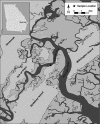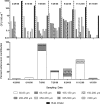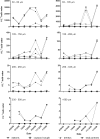Persistence and growth of the fecal indicator bacteria enterococci in detritus and natural estuarine plankton communities
- PMID: 22327586
- PMCID: PMC3318816
- DOI: 10.1128/AEM.06902-11
Persistence and growth of the fecal indicator bacteria enterococci in detritus and natural estuarine plankton communities
Abstract
Enterococci are used to evaluate recreational-water quality and health risks in marine environments. In addition to their occurrence in feces of warm blooded animals, they are also common epiphytes. We investigated the contribution of plankton- or particle-associated enterococci in estuarine and coastal water. Seven water and size-fractionated plankton samples were collected monthly between April 2008 and January 2009 in the tidal reaches of the Skidaway River (Georgia, USA). Each size fraction, along with filtered (<30 μm) and bulk estuarine water, was processed according to U.S. Environmental Protection Agency method 1600. Presumptive enterococci were selected and species were identified using carbon substrate utilization patterns. The highest average densities occurred within the 30-, 63-, 105-, and 150-μm size fractions, which also represented the majority (>99%) of the particles within the sampled water. Particle-associated enterococci accounted for as little as 1% of enterococci in bulk water in April to as much as 95% in July. Enterococcus faecalis was the most commonly isolated species from both water and plankton and represented 31% (16/51) and 35% (6/17) of the identified Enterococcus species from water and plankton, respectively. Enterococcus casseliflavus represented 29% of the selected isolates from plankton and 16% from water. Both E. faecalis and E. casseliflavus were able to survive and grow in plankton suspensions significantly longer than in artificial seawater. Enterococcus spp. may be highly concentrated in plankton and associated particles, especially during summer and fall months. These findings could have implications for the effectiveness of enterococci as an indicator of coastal water quality, especially in particle-rich environments.
Figures




References
-
- Altschul SF, Gish W, Miller W, Myers EW, Lipman DJ. 1990. Basic local alignment search tool. J. Mol. Biol. 215:403–410 - PubMed
-
- Anderson SA, Turner SJ, Lewis GD. 1997. Enterococci in the New Zealand environment: implications for water quality monitoring. Water Sci. Technol. 35:325–331
-
- Bordalo AA, Onrassami R, Dechsakulwatana C. 2002. Survival of faecal indicator bacteria in tropical estuarine waters (Bangpakong River, Thailand). J. Appl. Microbiol. 93:864–871 - PubMed
-
- Byappanahalli MN, Shively DA, Nevers MB, Sadowsky MJ, Whitman RL. 2003. Growth and survival of Escherichia coli and enterococci populations in the macro-alga Cladophora (Chlorophyta). FEMS Microbiol. Ecol. 46:203–211 - PubMed
Publication types
MeSH terms
LinkOut - more resources
Full Text Sources
Medical
Miscellaneous

